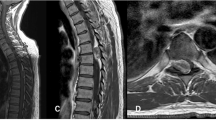Abstract
Purpose
We intend to report the largest series of spinal epidural cavernomas (SEC), discuss their clinical features, imaging characteristics, surgical findings, outcome analysis and compare them with similar reports in the literature.
Methods
Among the cases of spinal tumors treated surgically by the authors, there have been nine cases of SEC’s. All the data were collected prospectively and the cases have been followed after surgery up to the time of this analysis.
Results
There were six female and three male patients with the ages ranging between 13 and 74 years. The lesions were located in the thoracic spine (4 cases), lumbar spine (4 cases) and one at the sacral level. Clinical presentations included acute spinal pain and paraparesis in two, low back pain and radiculopathy in five, and slowly progressive myelopathy in the other two cases. The lesion was iso-intense with the spinal cord in T1W images and hyperintense in T2W images and showed strong homogeneous enhancement after contrast medium injection in most of our cases. In the presence of hemorrhage inside the lesion, it was hyperintense in both T1W and T2W MR sequences as in our case 6. In the single case presenting with acute hemorrhage, epidural hematoma was the only finding, our case 1. Complete surgical removal was achieved in all our cases, and confirmed by postoperative MRI.
Conclusion
SEC is hard to be differentiated from other epidural spinal lesions before intervention but should be considered in the list of differential diagnosis regarding its favorable outcome.



Similar content being viewed by others
Abbreviations
- SEC:
-
Spinal epidural cavernoma
- SSECA:
-
Solitary spinal epidural cavernous angioma
- MRI:
-
Magnetic resonance imaging
- LBP:
-
Low back pain
- CT:
-
Computed tomography
References
Acciari N, Padovani R, Pozzati E, Gaist G, Manetto V (1992) Spinal cavernous angioma: a rare cause of subarachnoid hemorrhage. Surg Neurol 37:453–456
Aoyagi N, Kojima K, Kasai H (2003) Review of spinal epidural cavernous hemangioma. Neurol Med Chir (Tokyo) 43:471–476
Appiah CA, Knuckey NW, Robbins PD (2001) Extradural spinal cavernous hemangioma: case report and review of the literature. J Clin Neurosci 8:176–179
Carlier R, Engerand S, Lamer S, Vallee C, Bussel B, Polivka M (2000) Foraminal epidural extraosseous cavernous hemangioma of the cervical spine. Spine 25:629–631
Caruse G, Galarza M, Borghesi I, Pozzati E, Vitale M (2007) Acute presentation of spinal epidural cavernous angioma: case report. Neurosurgery 60:E575–E576
Cho JH, Chung YN, Wang KC, Cho BK (2006) Spinal cavernous hemangioma causing sudden paraplegia in a 23-month-old kid. J Korean Neurosurg Soc 40:273–276
D’Andrea G, Ramundo OE, Trillo G, Roperto R, Isidori A, Ferrante L (2003) Dorsal foramenal extraosseous epidural cavernous hemangioma. Neurosurg Rev 16:292–296
Feng J, Xu YK, Li L, Yang RM, Ye XH, Zhang N, Yu T, Lin BQ (2009) MRI diagnosis and preoperative evaluation for pure epidural cavernous hemangiomas. Neuroradiology 1:741–747
Floeth F, Riemenschneider M, Herdmann J (2010) Intralesional hemorrhage and thrombosis without rupture in a pure spinal epidural cavernous angioma: a rare cause of acute lumbar radiculopathy. Eur Spine J 19(supp 12):193–196
Goyal A, Singh AK, Cupta V, Tatake M (2002) Spinal epidural cavernous haemangioma: a case report and review of literature. Spinal cord 40:200–202
Hatiboglu MA, Iplikcioglu AC, Ozcan D (2006) Epidural spinal cavernous hemangioma: case report. Neural Med Chir (Tokyo) 46:455–458
Khalatbari MR, Hamidi M, Moharamzad Y (2011) Pediatric intramedullary cavernous malformation of the conous medullaris: case report and review of the literature. Childs Nerv Syst 27:507–511
Leu NH, Chen S, Chou JM (2006) MR features of posterior spinal epidural cavernous hemangioma: a case report. Chin J Radiol 31:127–131
Minh NH (2005) Cervicothoracic spinal epidural cavernous hemangioma: case report and review of the literature. Surgical Neurol 64:83–85
Nagi S, Megdiche H, Bouzaidi K, Haouet S et al (2004) Imaging features of spinal epidural cavernous malformations. J Neuroradiol 31:208–213
Padovani R, Tognetti F, Proietti D et al (1962) Extradural Cavernous hemangioma. Surg Neurol 18:463–465
Padovani R, Acciari N, Giulioni M et al (1997) Cavernous angiomas of the spinal district: surgical treatment of 11 patients. Eur Spine J 6:298–303
Park ES, Park JS, Kim E (2008) Spinal epidural cavernous angioma: a case report. Kor J Spine 5:99–101
Santoro A, Piccirilli M, Bristot R et al (2005) Extradural spinal cavernous angioma: report of seven cases. Neurosurg Rev 28:313–319
Saringer W, Nobauer I, Haberler C, Ungersbock K (2001) Extraforaminal, thoracic, epidural cavernous hemangioma: case report with analysis of magnetic resonance imaging characteristics and review of the literature. Acta Neurochir 143:1293–1297
Sarikaya-Seiwert S, Gierga K et al (2010) Solitary spinal epidural cavernous angiomas in children presenting with acute neurological symptoms caused by hemorrhage: report of 2 cases. J Neurosurg Pediatr 5:89–93
Satpathy DK (2009) Spinal epidural cavernous hemangioma with myelopathy: a rare lesion. Neurol India 57:88–90
Shin JH, Lee HK, Rhim SC (2001) Spinal epidural cavernous hemangioma: MR findings. J Comput Assist Tomogr 25:257–261
Sohn MJ, Lee DJ, Jeon SR, Khang SK (2009) Spinal radiosurgical treatment for thoracic epidural cavernous hemangioma presenting as radiculomyelopathy: technical case report. Neurosurgery 64:E 1202
Talacchi A, Spinnato S, Alessandrini F, Iuzzolinop P, Bricolo A (1999) Radiologic and surgical aspects of pure spinal epidural cavernous angiomas: report on 5 cases and review of the literature. Surg Neurol 52:198–203
Tekkok IH, Akpinar G, Gungen Y (2004) Extradural lumbosacral cavernous hemangioma. Eur Spine J 13:469–473
Wang P, Xin XT, Lan H et al (2011) Spontaneous cervical epidural hematoma during pregnancy: case report and literature review. Eur Spine J 20(Suppl 2):S176–S179
Zevgaridis D, Buttner A, Weis S, Hamburger C, Reulen HJ (1998) Spinal epidural cavernous hemangioma: report of three cases and review of the literature. J Neurosurg 88:903–908
Conflict of interest
None.
Author information
Authors and Affiliations
Corresponding author
Rights and permissions
About this article
Cite this article
Khalatbari, M.R., Abbassioun, K. & Amirjmshidi, A. Solitary spinal epidural cavernous angioma: report of nine surgically treated cases and review of the literature. Eur Spine J 22, 542–547 (2013). https://doi.org/10.1007/s00586-012-2526-2
Received:
Revised:
Accepted:
Published:
Issue Date:
DOI: https://doi.org/10.1007/s00586-012-2526-2




